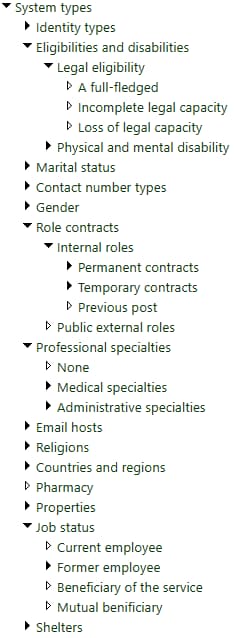|
Anytime Anywhere

Working anytime anywhere refers to the ability of individuals to work from any location, as long as they have access to the necessary tools and resources, such as a computer, internet connection, and communication tools. This trend has become increasingly popular in recent years, as technology has made it easier for people to work remotely and stay connected with their teams.
In today's fast-paced healthcare environment, healthcare management information systems (HMIS) have become an essential tool for healthcare organizations. Active server pages (ASP) web applications offer several benefits for healthcare organizations that need anytime, anywhere access to data through doctors, nurses, patient, and administrative portals. Here are some of the advantages of using ASP web applications in healthcare.
- Accessibility: One of the most significant advantages of ASP web applications is their accessibility. Since these applications are hosted on the web, they can be accessed from anywhere and at any time. Healthcare providers can access data through secure portals from their desktops, laptops, allowing them to provide better instant patient care.
- Real-time data access: ASP web applications allow healthcare providers to access real-time data, such as patient records, lab results, and medication lists. This real-time access to data helps providers make informed decisions, improve patient outcomes, and reduce the risk of medical errors.
- Flexibility: ASP web applications are highly flexible and can be customized to meet the specific needs of healthcare organizations. For example, doctors, nurses, patients, and administrative staff can access different portals with unique features and functions tailored to their respective roles. This flexibility allows healthcare organizations to optimize workflows, improve communication, and increase productivity.
- Cost-effective: ASP web applications are cost-effective compared to traditional software systems. Healthcare organizations can avoid the expense of purchasing and maintaining software and hardware infrastructure. ASP web applications are typically offered on a subscription basis, allowing organizations to pay for only the services they use.
- Scalability: ASP web applications can easily scale to meet the growing needs of healthcare organizations. As patient volumes increase, healthcare organizations can add more users and resources to the system without having to invest in additional hardware or software. This scalability helps healthcare organizations to remain efficient and effective as they grow.
- Enhanced Security: ASP web applications are highly secure and provide advanced security features, such as encryption, firewalls, and intrusion detection systems. This enhanced security helps protect sensitive patient data from unauthorized access and ensures compliance with industry regulations, such as HIPAA.
In conclusion, ASP web applications offer several benefits for healthcare organizations. By providing accessibility, real-time data access, flexibility, cost-effectiveness, scalability, and enhanced security, ASP web applications can help healthcare organizations improve patient care, streamline workflows, and increase productivity. Healthcare organizations that implement ASP web applications can stay competitive, meet regulatory requirements, and achieve their business goals.
We Recommend Microsoft Edge

Microsoft Edge is a web browser that has been steadily growing in popularity among users. One of the many features that sets it apart from other web browsers is its ability to translate web pages into various languages, including Arabic.
In this article, we will explore the benefits of Microsoft Edge's translation feature, particularly in its ability to translate web pages to Arabic or othor languages. Microsoft Edge's translation feature is powered by Microsoft Translator, a cloud-based machine translation service. This service provides an accurate translation of text from one language to another, and it is particularly useful for individuals who may not be fluent in the language of the web page they are viewing. For Arabic speakers, this feature is particularly useful as it allows them to access and understand content that may not be available in their native language. For instance, if an individual wants to read a news article that is written in English, they can use Microsoft Edge's translation feature to read the article in Arabic, without having to manually translate each word. Another benefit of Microsoft Edge's translation feature is that it can help with language learning. By translating web pages into Arabic, users can learn new vocabulary and sentence structures, and gain a better understanding of the language. Microsoft Edge's translation feature is also beneficial for businesses that operate in the Middle East.
By translating their website into Arabic, businesses can expand their customer base and reach a wider audience. This is particularly important for businesses that offer products or services in the technology sector, as the Middle East is one of the fastest-growing markets for technology products. Overall, Microsoft Edge's translation feature is a valuable tool for anyone who needs to access information that is not available in their native language. For Arabic speakers, this feature is particularly beneficial as it allows them to access content that may not be available in their language. Whether you are a language learner, a business owner, or simply someone who wants to stay informed, Microsoft Edge's translation feature is a powerful tool that can help you achieve your goals. Know how!
The Organization Role Manager

Managing Employee Roles and Specialties in Your organization is important in the prespective of creating a clear view for everyone. Managing employee roles and specialties in your organization can be a complex task, but with the right tools and systems in place, you can make it more efficient and effective. In this article, we'll explore how you can use a role manager to define roles in your organization, assign primary and secondary roles to employees, and track their specialties and contract types.
Defining Roles in Your Organization:
Roles are the various positions that exist within your organization, such as manager, employee, and administrator. By defining roles, you can ensure that each employee has a clear understanding of their responsibilities and what they are authorized to do. A role manager is a tool that you can use to define roles in your organization. This tool provides a way to add, delete, and modify roles as needed. For example, you might have a "manager" role that has access to certain resources and a "sales representative" role that has access to other resources.
Assigning Primary and Secondary Roles:
Each employee in your organization may have one or more roles that they perform. A primary role is the main role that an employee performs, while a secondary role is an additional role that an employee may take on. For example, an employee might have a primary role as an accountant, but also take on a secondary role as a team leader. By using a role manager, you can assign primary and secondary roles to employees. This helps ensure that each employee has a clear understanding of their responsibilities and can access the resources they need to perform their roles.
Tracking Specialties and Contract Types:
In addition to primary and secondary roles, you may also want to track an employee's specialties and contract types. Specialties are specific areas of expertise that an employee may have, such as financial analysis or project management. Contract types are the type of contract that an employee has, such as full-time or part-time. By tracking an employee's specialties and contract types, you can better manage your workforce and ensure that each employee is performing the right tasks. For example, you might assign an employee with a specialty in financial analysis to a project that requires those skills.
Conclusion:
In conclusion, managing employee roles and specialties in your organization is critical to ensuring that your workforce is efficient and effective. By using a role manager, you can define roles, assign primary and secondary roles to employees, and track their specialties and contract types. This can help you better manage your workforce and ensure that each employee is performing the right tasks.
|
|
The Romanizer
 Using the power of javascript the Romanizer that is an innovation of Integra will help Arabic speaking users to use their native arabic letters in writing person's names in a way they are used to while the system will convert the Arabic letters to Roman letters, so that no way personal differences can occur between entries. This is intended to make it easier during searching and filtering processes in the database and making it easier to find previously enrolled persons.
Using the power of javascript the Romanizer that is an innovation of Integra will help Arabic speaking users to use their native arabic letters in writing person's names in a way they are used to while the system will convert the Arabic letters to Roman letters, so that no way personal differences can occur between entries. This is intended to make it easier during searching and filtering processes in the database and making it easier to find previously enrolled persons.
Finding previously inserted records through searching by name, phone numbers or file number will normally avoid double entries and redundancy of data. This is not only limited to Arabic text, actually it can be customised to work with any other language provided we get help with that language beforehand.
Our Romanizer is a javascript function that converts Arabic names to a consistent Romanized form. This is useful for efficient querying and filtering capabilities, as the Romanized form of the name will always be the same regardless of how the user enters it. Our Romanizer function removes diacritics and non-Arabic characters from the input name using regular expressions. It then maps each remaining Arabic character to its corresponding Romanized form using a predefined mapping object. Finally, it converts the result to capitalised initial form to ensure consistency. For example, if a user enters the Arabic name “محمد”, our Romanizer will always return the Romanized form (Mohamed), not (Mohammed) or (Mohamad) regardless of how the user enters it (e.g., “محمد”, will be alway be “Mohamed” and “علي” will always be “Aely”, etc.). This enables efficient querying and filtering of Arabic names in a consistent and standardised manner.
Data security issues

When it comes to hosting your business's applications and data, you have two main options: on-premise or cloud hosting. On-premise hosting involves hosting your applications and data on servers that are physically located within your own facility, while cloud hosting involves hosting your applications and data on servers that are located in a remote data center, often run by a third-party provider. While there are many factors to consider when choosing between these two options, one of the most important is data security. In this article, we'll explore the differences between on-premise and cloud hosting when it comes to data security.
On-premise hosting offers a high degree of control over your data security. Because the servers are physically located in your own facility, you have complete control over who has access to them. You can set up firewalls and other security measures to protect your data from external threats, and you can monitor your servers closely to detect any suspicious activity. Additionally, if you have highly sensitive data, you may feel more comfortable having it stored in-house rather than in a remote data center that is managed by a third-party provider.
However, there are also some downsides to on-premise hosting when it comes to data security. First, setting up and maintaining your own servers can be costly and time-consuming, and it requires a high level of technical expertise. If you don't have a dedicated IT staff, you may find it difficult to keep your servers secure and up-to-date with the latest security patches. Additionally, on-premise hosting is vulnerable to physical threats, such as theft or natural disasters. If your facility experiences a break-in or a fire, your servers and data could be destroyed.
Cloud hosting, on the other hand, offers some unique advantages when it comes to data security. Because your data is stored in a remote data center, it is protected by the security measures put in place by the third-party provider. These measures typically include firewalls, intrusion detection systems, and other security tools that are designed to protect your data from external threats. Additionally, cloud providers typically employ highly skilled security experts who are responsible for monitoring the data center and responding to any security incidents.
Cloud hosting also offers some advantages when it comes to disaster recovery. Because your data is stored off-site, it is protected from physical threats like theft or natural disasters. Additionally, many cloud providers offer redundant storage and backup solutions that can help ensure that your data is always available, even in the event of a major outage or disaster.
However, cloud hosting is not without its downsides when it comes to data security. One of the biggest concerns is the potential for data breaches. While cloud providers generally have strong security measures in place, no system is 100% foolproof, and there is always a risk of a data breach. Additionally, if your data is stored in a remote data center, you may have less control over who has access to it. If you have highly sensitive data, you may feel more comfortable keeping it in-house where you can control access more tightly.
Ultimately, the decision of whether to choose on-premise or cloud hosting for your business will depend on a variety of factors, including your budget, your technical expertise, and the sensitivity of your data. When it comes to data security, both options have their pros and cons, and it's up to you to decide which approach is best for your business. Whichever option you choose, it's important to take data security seriously and to implement strong security measures to protect your data from external threats.
The Type Manager
 The HMIS Type Manager is a self-joining entity designed to include a wide variety of predefined types and identifiers for the business. These include personal identifiers such as national ID, residence papers “Iquamas”, and passport, as well as eligibility and disability types, world countries, cities, and districts, employee contract types, job status types and employee specialties, properties, pharmacy drug names, and many others. The purpose of this Type Manager is to facilitate the automatic entry of predefined identifiers avoiding the user selection during record insertions. It makes the process more efficient and accurate. The system uses a form of AI to understand and manage itself, improving the overall performance of the HMIS. If I were to be more comprehensive, we would say that the HMIS Type Manager design is a very useful tool that provides a centralised repository for managing different (heterogenous) types of data used within the system. It uses a self-join entity structure to organise different data types in a tree hierarchy, which allows for a flexible and extensible approach to managing various types of data.
The HMIS Type Manager is a self-joining entity designed to include a wide variety of predefined types and identifiers for the business. These include personal identifiers such as national ID, residence papers “Iquamas”, and passport, as well as eligibility and disability types, world countries, cities, and districts, employee contract types, job status types and employee specialties, properties, pharmacy drug names, and many others. The purpose of this Type Manager is to facilitate the automatic entry of predefined identifiers avoiding the user selection during record insertions. It makes the process more efficient and accurate. The system uses a form of AI to understand and manage itself, improving the overall performance of the HMIS. If I were to be more comprehensive, we would say that the HMIS Type Manager design is a very useful tool that provides a centralised repository for managing different (heterogenous) types of data used within the system. It uses a self-join entity structure to organise different data types in a tree hierarchy, which allows for a flexible and extensible approach to managing various types of data.
The Type Manager includes parent types for various categories for example world countries that includes children (cities); which inturn includes leaves (districts). Here we came to define a person’s address up to the district. Employee contract types, job status types, specialties types, properties, pharmacy drug names, and many other types. By having a centralised repository for these types, the system can auto-populate predefined identifiers during record insertion, which greatly simplifies data entry for users and improves data quality. Additionally, by having a structured and consistent approach to managing types of data, the system is more intelligent and can understand the relationships between different types of data. This allows for improved data analysis, reporting, and decision-making within the system.
It worth to say that type manager is not intended for users or administration instead it is desigend only to facilitate data manipulation and use, the project managers and developers are only the ones who has access to this module.
The type manager is designed for managing sensitive business data in your healthcare facility. This is an important step to ensure the security and integrity of your data, as it limits access to only those who are authorized to work on the system and have a need to know.
By restricting access to the type manager to system developers and project managers, you can ensure that only those who understand the implications of their actions on the data can interact with it. This can help prevent accidental data loss or corruption, as well as malicious attacks by unauthorized users.
However, it's important to keep in mind that security is an ongoing process, and you should regularly review and update your access controls and security measures as needed to protect your data. Additionally, you may want to consider implementing auditing and logging features to track access to the type manager and identify any suspicious activity. Overall, the type manager you have designed can be an important tool in protecting sensitive business data, but it's important to take a holistic approach to security and regularly review and update your measures to stay ahead of potential threats.
Overall, the HMIS Type Manager is a powerful and important tool for managing data within the HMIS system, and it provides many benefits to both users and administrators.
|